Plains in Transition
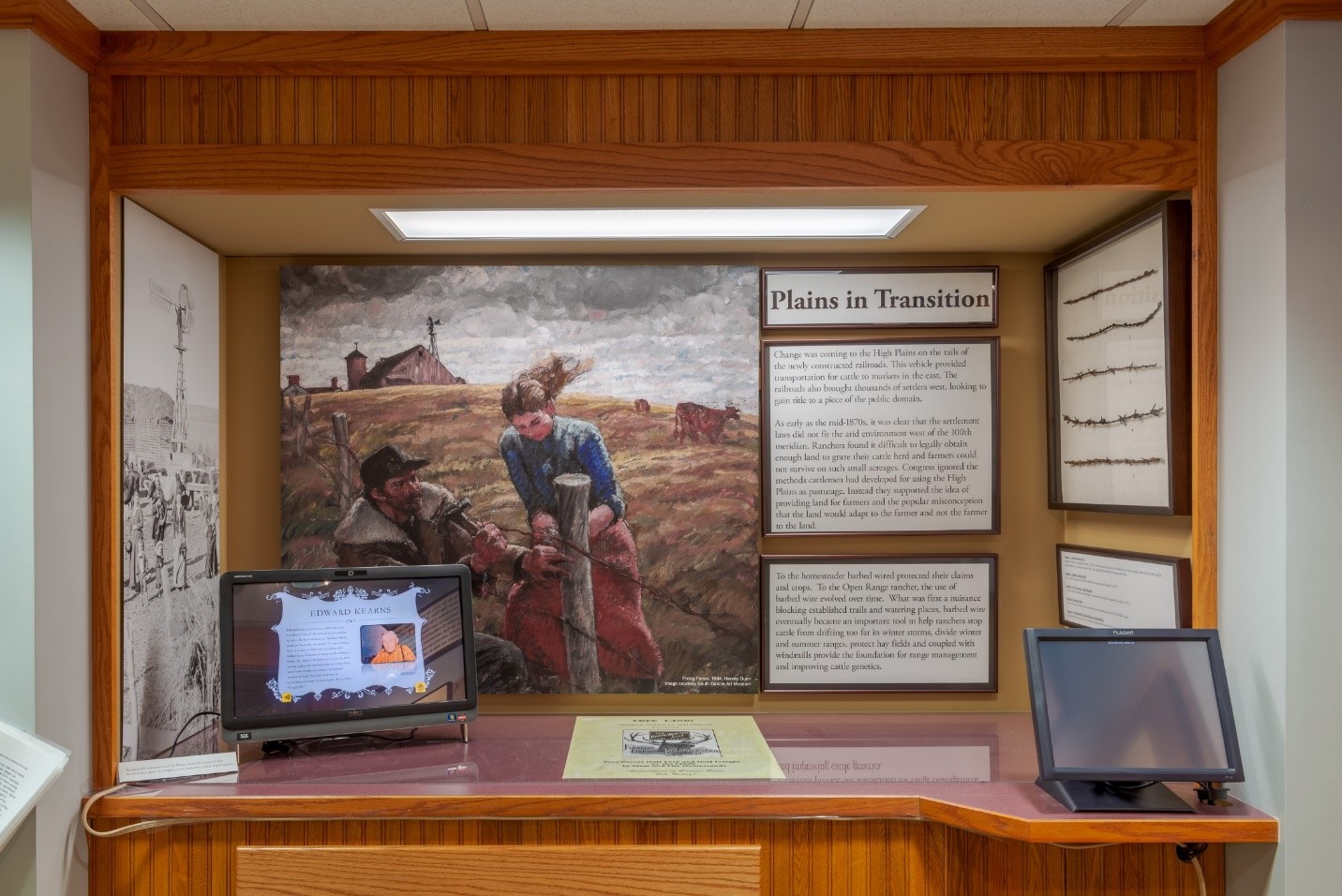
As early as the mid-1870s, it was clear that the settlement laws did not fit the arid environment west of the 100th meridian. Ranchers found it difficult to legally obtain enough land to graze their cattle herds and farmers could not survive on such small acreages. Congress ignored the methods cattlemen had developed for using the High Plains as pasturage. Instead they supported the idea of providing land for settlers to farm and the popular misconception that the land would adapt to the farmer and not the farmer to the land. As early as 1875 the Commissioner of the General Land Office in his annual report was urging Congress to modify the existing laws to meet the needs of the settlers in the arid west.

Settlement Acts
The four settlement laws which had the most impact on the open range in Northwest Nebraska were: the Preemption Act, Homestead Act, Timber Culture Act, and the Kinkaid Act.
- Preemption Act - 1841-1891
Must be 21 years old, head of a family, a U.S. citizen or file a declaration of intention to become a U.S. citizen. Settlers could file on surveyed or un-surveyed land. As long as the settler complied with the terms of the act, his or her claim 'preempted' previous claims.
- Homestead Act - 1862-1976 (1986 for Alaska)
The Homestead Act was one of several settlement laws that transferred Public land to private ownership and led directly to the end of the open range ranching era.
A settler was required to complete an application affirming that he or she was age 21 or the head of a family, a U.S. citizen or had declared intention to become one, not already the owner of 320 acres of land within the U.S., that he had not quit or abandoned land owned by him in the same state or territory, and that the homestead would be for his exclusive use. The entry was then recorded in the records of the land office upon payment of a filing fee. If actual residence had not been established, the settler had six months in which to do so.
Designed to make land available "free" to those who would live on and cultivate the tract for a period of time usually five years.
Homestead National Monument near Beatrice, Nebraska is dedicated to preserving the history of the homesteaders who staked their claims in the western U.S.
You can learn more about the Homestead Act
- Timber Culture Act - 1873-1891
Originally, a timber claim could be filed by anyone. In 1874, the act was amended to require claimants to meet the same age and citizenship qualifications as the preemption and homestead acts. Not more than 160 acres could be claimed. Later amendments to the law made it possible for the total acres claimed to be in several smaller tracts as long as the aggregate did not exceed 160 acres and no more than one 160 acre timber claim was permitted in each section. Timber claims did not require residence on the land.The original law provided for the planting of forty acres of trees on each 160 acres. This requirement was later reduced to ten acres, to be planted according to the specified guidelines. (See source for guidelines.) Not less than 2,700 trees were to be planted on each of the ten acres, or a total of 27,000 trees! If less than 160 acres were claimed, the acreage of trees was reduced proportionately. Non-compliance with the tree planting procedures made the timber claim subject to cancellation after one year. Certain exceptions or extensions were allowed in the event of destruction of the plantings by grasshoppers or the failure of seeds or cuttings to germinate.
This act was designed to promote tree-planting in the treeless areas of the West.Of all the land laws affecting Nebraska, the Timber Culture act was perhaps the least successful and subject to many abuses.
- Kinkaid Act - 1904- 1976
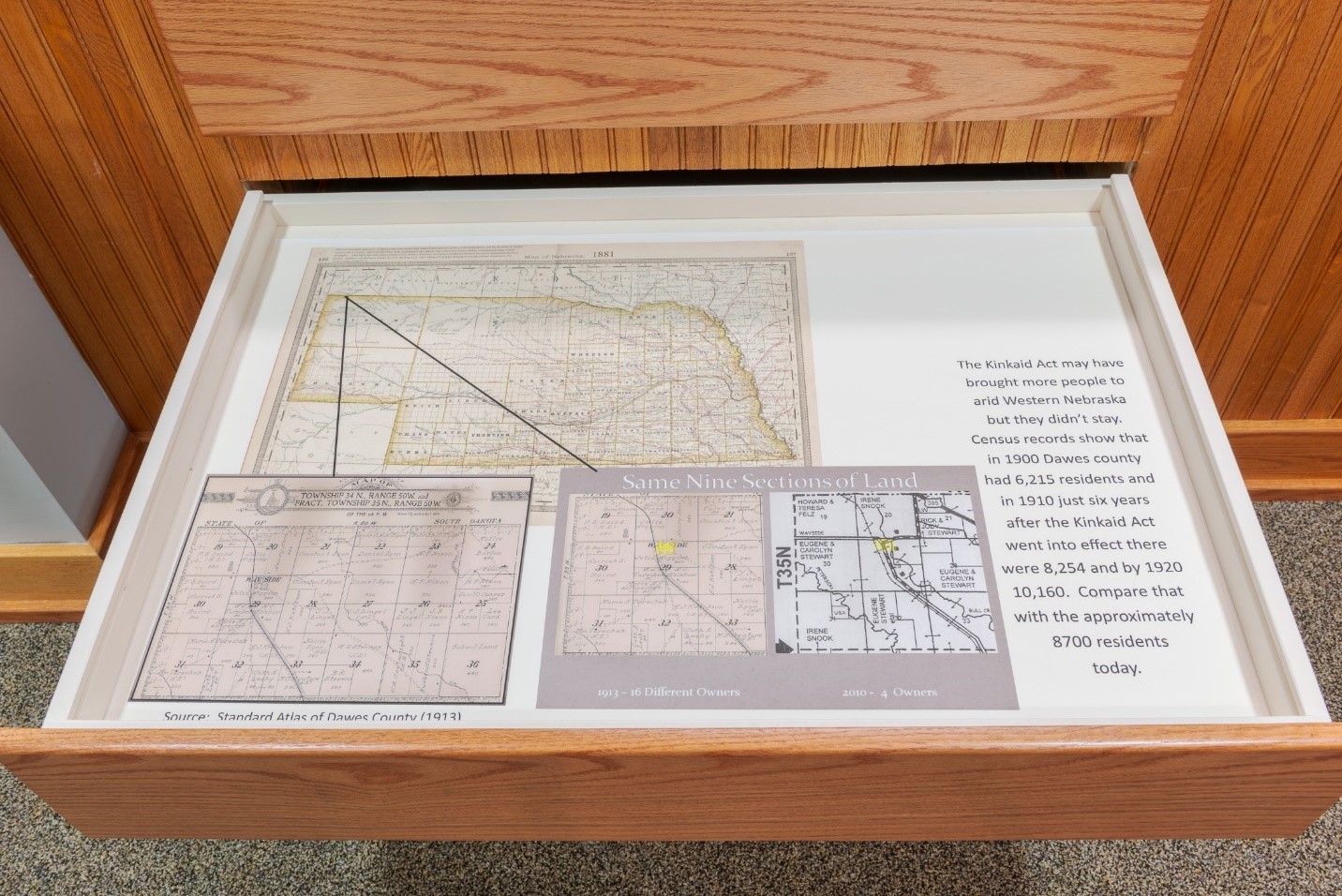 The Kinkaid Act of 1904, authored by Nebraska Congressman Moses P. Kinkaid, was a special homestead law which applied only to 37 western and central Nebraska counties. This act allowed 640 acre homesteads in the designated areas, except for lands set aside as being suitable of irrigation.The act was an effort to respond to the fact that 160 acre tracts were far too small for productive agriculture and ranching in the relatively arid Sand Hills and High Plains regions of Nebraska.
The Kinkaid Act of 1904, authored by Nebraska Congressman Moses P. Kinkaid, was a special homestead law which applied only to 37 western and central Nebraska counties. This act allowed 640 acre homesteads in the designated areas, except for lands set aside as being suitable of irrigation.The act was an effort to respond to the fact that 160 acre tracts were far too small for productive agriculture and ranching in the relatively arid Sand Hills and High Plains regions of Nebraska.
The settlement of Wayside, Nebraska is a case study of the Kinkaid Act.The town of Wayside was started in 1909 located near the railroad. The Fremont, Elkhorn and Missouri Valley built the line but merged in 1903 with the Chicago and North Western Railroad. Jennie Rivers came to Wayside in July of 1909 after being persuaded by friend in Oelrichs, South Dakota that the new town needed a hotel. She and her daughter Nona lived in one of the railroad section houses while the hotel was being built.Nona wrote that almost everyone in the community had a hand in building the hotel. It is from Nona's scrapbook that we can look back and see life in a town built by the Kinkaid Act.

Barb Wire-The Thorny Fence
Fences reflect beliefs about who has rights to use land and its resources. Deciding whether to fence in crops or fence in cattle meant deciding what land was public what was private property and who had to pay for the fences.
From the 1500s to 1800, livestock enclosures consisted of rail fences where timber existed, rock walls where stone was available, brush, cactus or hedge fences and ditches. The shortage of raw materials and the amount of labor required in construction limited these fences to small enclosures around homesteads and ranches.
Dating back to 400 A.D., the process of pulling hot, bloom iron through dies in a drawing plate produced short lengths of various sizes of smooth wire, but for centuries problems of quality and quantity remained unsolved. Eventually devices were invented to pull longer pieces of wire and smooth irregularities. By 1870, good quality smooth wire was readily available in all sizes and lengths. Stockmen used the smooth wire in fencing but found it was not a dependable deterrent to livestock passage.
In 1867, two inventors tried adding points to the smooth wire in an effort to make a more effective deterrent. One example was not practical to manufacture, the other experienced financial problems. In 1868, Michael Kelly invented a practical wire with points which was used in quantity until 1874.
Joseph F. Glidden of Dekalb, Illinois attended a county fair where he observed a demonstration of a wooden rail with sharp nails protruding along its sides, hanging inside a smooth wire fence. This inspired him to invent and patent a successful barbed wire in the form we recognize today. Glidden fashioned barbs on an improvised coffee bean grinder, placed them at intervals along a smooth wire, and twisted another wire around the first to hold the barbs in a fixed position.
The advent of Glidden's successful invention set off a creative frenzy that eventually produced over 570 barbed wire patents. It also set the stage for a three-year legal battle over the rights to these patents.
When livestock encountered barbed wire for the first time, it was usually a painful experience. The injuries provided sufficient reason for the public to protest its use. Religious groups called it "the work of the devil," or "The Devil's Rope" and demanded removal.
To the homesteader barbed wired protected their claims and crops. To the Open Range rancher, the use of barbed wire evolved over time. What was first a nuisance blocking established trails and watering places, barbed wire eventually became an important tool to help ranchers stop cattle from drifting too far in winter storms, divide winter and summer ranges, protect hay fields and coupled with windmills provide the foundation for range management and improving cattle genetics.
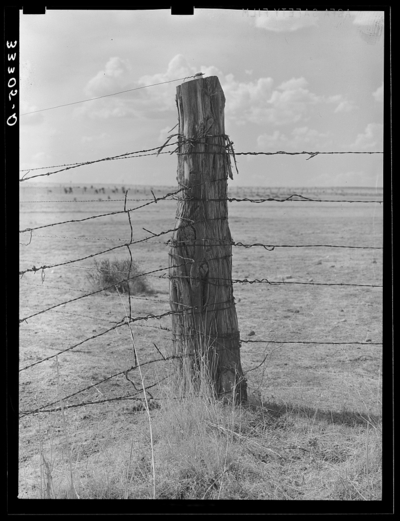
Barb Wire Samples
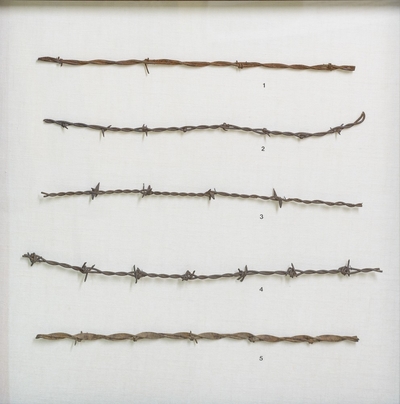
Sample 1 - Railroad Barbed Wire
Joseph F. Glidden patent dated November 24, 1874. The railroads were large buyers of barbed wire and had a wire made special for them that could be easily identified in an attempt to stop wire theft. This sample of Railroad Wire; has atypical line wires.
Sample 2 - Glidden Coiled on Barb
This very old rusty piece of nearly flat barbed wire was patented on November 24, 1874
Sample 3 - H. N. Frentress -Split Diamond
This two strand wire with diamond shaped two point sheet metal barb was patented December 14, 1875.
Sample 4 - Ross Four Point
This two strand wire features a four-point barb and was patented on June 10, 1879 by Noble G. Ross.
Sample 5 - Brinkerhoff's Narrow Ribbon and Round Wire
This twisted sheet metal wire with a single wire strand and two point barb on a wire strand was patented by John J. Brinkerhoff on August 11, 1885.
The Windmill Icon of the Plains
While a cowboy on horseback may be the most recognizable image of European settlement of the High Plains of North America in the last quarter of the 19th century, pictures of windmills, standing tall on an open prairie landscape, almost certainly come in a close second.
As the short reign of open range ranching came to an end, the windmill was an indispensable tool for the farmers and stockmen who were settling in on the prairie. Raising crops or livestock is impossible without water, and getting it to the places it was needed on the arid plains, where year-round, free running streams are rare and rainfall can be scant and unpredictable, was a requirement for a settler.
The self-governing windmill, an invention that was first successfully commercialized in the 1860s, provided a simple way to get underground water to the surface so it could be put in tanks for livestock to drink or diverted to fields and gardens to grow life-sustaining crops.
The machines converted the energy of the winds that coursed over the prairies to an up and down motion that operated a simple water pump. The self-governing mechanism that kept them from destroying themselves in high winds was key to their success, and even a simple wooden windmill could lift water from as deep as 300 feet. In the 1870s and 1880s, as homesteaders and settlers poured onto the lands where buffalo once roamed, they began installing windmills in substantial numbers. For a rancher, raising cattle on land newly enclosed by barb wire fences, the windmill allowed placement of watering tanks for their livestock, instead of having to drive the animals to a stream or lake many miles away.

Railroads
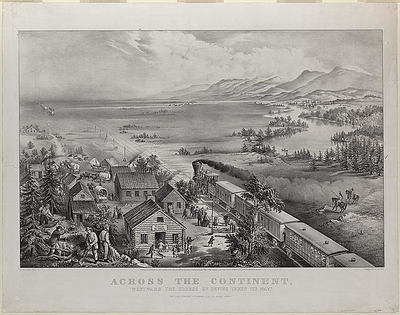
The change put in motion by the settlement acts, was hastened on the rails of the newly constructed railroads that reached the Plains in the mid-1800s. These vehicles provided transportation for cattle to markets in the east and brought thousands of settlers west, looking to gain title to a piece of the public domain.
Watch the Development of Railroad Lines In Nebraska


Railroad Telegraph Key
A telegraph ‘key’ like this was typically mounted to the desk of an operator, who used it to send messages in Morse code to a receiving device at another railroad station. The wires that connected the key to the telegraph line were connected to mounting bolts under the desk. This key from the Chicago, Burlington and Quincy line is stamped CB&Q, with the number 2268, the maker's name (Bunnell) and an 1881 patent date on the main lever. The key, part of the Coffee Gallery collection, includes the original wingnuts but the spring is a replacement.
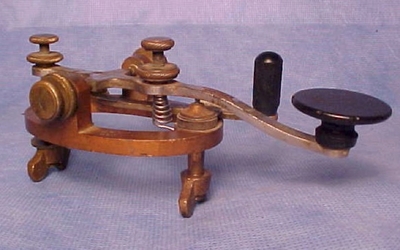
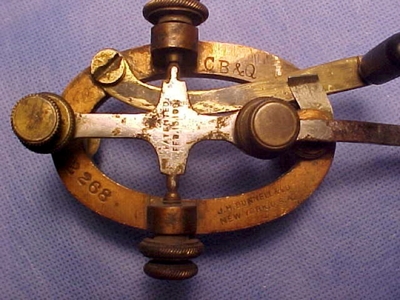
Shipping Cattle By Rail
There have been numerous changes in the cattle industry in this country but few have been more visible or had a greater impact than the development and evolution of transportation of livestock to markets.
In late the 1800s the cattle industry was regionally located almost entirely in the West and was producing grass fattened steers four or five years that were shipped by train to accumulation points known as stockyards all located in the east. Packing plants were located near the stockyards.
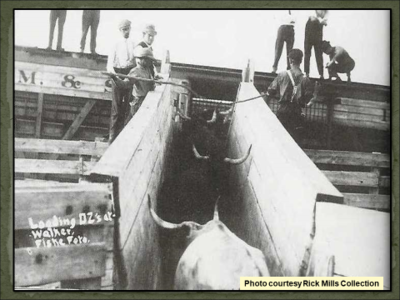
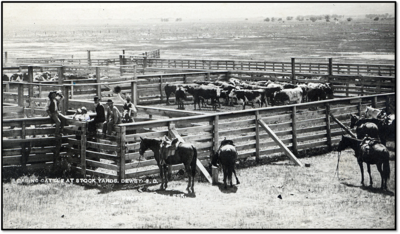
Shipping yards at Dewey, S. D. ca. 1907 from the Gib Taylor Collection Courtesy Annee Cassens
- Choose question

Cattle ranchers preparing to transport their livestock to eastern markets filled out the shipping contract with the railroad and ordered stock cars at their local shipping point or railroad dept.
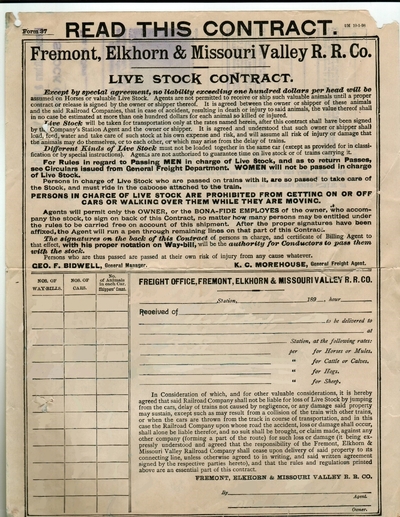
The Rest of the Story
What happened to those brave souls who came to the arid plains to farm?
Most went broke after numerous crop failures and moved back home. Some moved further west to try their luck at other ventures. A few stayed and adapted their methods to fit the climate. Those hardy individuals bought land from the disillusioned settlers who left and farmed crops that would grow in the dry region such as winter wheat and alfalfa. They also diversified and raised cattle, horses, sheep and pigs. The open range ranchers did the same. When the winds of change threatened the existence of open range ranching, many in an effort to protect their grazing land fenced public domain to keep the "grangers" out.
But as time progressed it was apparent that time and the arid plains would prevail and starve the farmers out. Many open range ranchers who survived the harsh winters and Big Die Up, obtained title to important watering sources, hay grounds and headquarter locations through the various settlement acts. Many who had fenced public ground took their fences down.
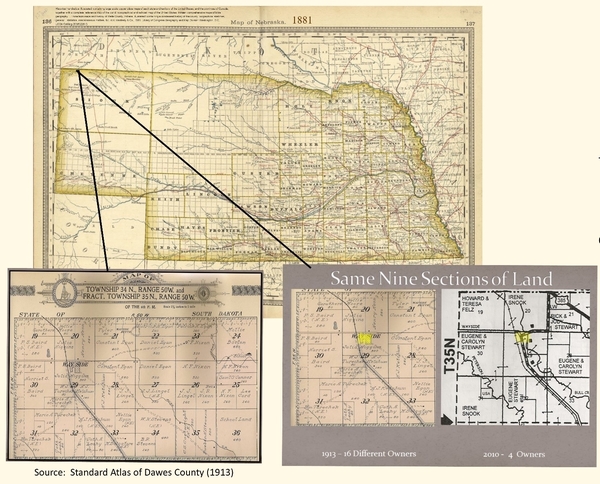
The maps shown above of Wayside, Nebraska tell the story. The Kinkaid Act may have brought more people to arid western Nebraska, but they didn't stay. Census records show that in 1900 Dawes County had 6,215 residents and in 1910, just six years after the Kinkaid Act went into effect there were 8,254, and by 1920 10,160. Compare that with the approximately 8,700 residents today.